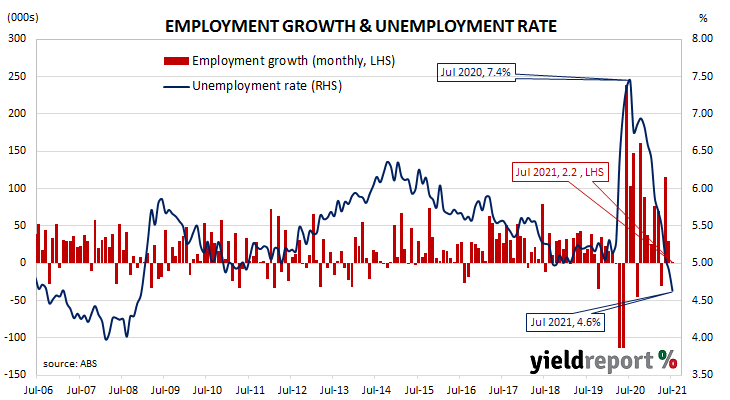Summary: Total employment increases by 2,200 in July, more than expected; reference period only captures early part of lockdowns; participation rate declines 0.2ppt to 66.0%; fewer jobseekers outweighs smaller available workforce, sends jobless rate to 4.6%; slightly more part-time, slightly fewer full-time jobs; aggregate work hours falls 0.2%; “good reason to think” jobs market is more resilient than last year; “big falls” in employment still to come; underemployment rate up from 7.9% to 8.3%.
Australia’s period of falling unemployment came to an end in early 2019 when the jobless rate hit a low of 4.9%. It then averaged around 5.2% through to March 2020, bouncing around in a range from 5.1% to 5.3%. Leading indicators such as ANZ’s Job Ads survey and NAB’s capacity utilisation estimate suggested the unemployment rate would rise in the June 2020 quarter and it did so, sharply. The jobless rate peaked in July 2020 but fell below 7% a month later and then continued to trend lower.
The latest Labour force figures have now been released and they indicate the number of people employed in Australia according to ABS definitions increased by just 2,200 in July. The rise was less than June’s revised increase of 29,100 but it was also in contrast with the generally expected fall of 46,200.
“Overall, we are inclined to ‘fade’ the strength of today’s data. Indeed, the reference period was 4 July to 17 July, which only captured the early part of lockdowns, which were subsequently tightened and broadened,” said UBS economist George Tharenou.
Domestic Treasury bond yields fell on the day. By the close of business, the 3-year ACGB yield had slipped 1bp to 0.23% while 10-year and 20-year yields each finished 4bps lower at 1.07% and 1.71% respectively.
In the cash futures market, expectations of any change in the actual cash rate remained soft. At the end of the day, contract prices implied the cash rate would gradually rise from its current rate of 0.03% to around 0.22% by December 2022.
The participation rate declined from 66.2% to 66.0% as the total available workforce decreased by 37,700 to 13,795,600. The number of unemployed persons fell by 39,900 to 639,200; the lower unemployment number outweighed fewer people in the workforce, leading to a drop in the unemployment rate from 4.9% to 4.6%.


